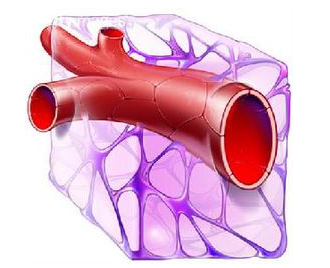Let me now show you a second drawing that I did.
下面来看第二种
This is our second type of capillary.
这是第二种毛细血管
This is a fenestrated capillary.
这是有孔毛细血管
You can see the major difference between this one and the first one is that the second one has little holes.
大家可以看到第一种和第二种毛细血管的区别,就是第二种血管有小孔
We call them fenestrations. Fenestrations
这是血管的孔
So this is a fenestrated capillary.
这是有孔毛细血管
And these pores. I'm gonna just label them.
而这些小孔,我标记一下
You can also call them pores or holes.
这叫做小孔,或者小洞
These pores are all over the capillary. Right?
毛细血管上都有小孔
So we still have, just as before, four cells, four nuclei and one little red blood cell poking its way through.
还是跟第一个一样,有四个细胞,有一个红细胞在其中穿过

And you still have the intercellular cleft.
还是有细胞间隙
So, just to show you where it is on this one,
大家看这个位置
it's right there where the two cells really don't meet up so nicely.
在这里,两个细胞不接触的地方
There's a little gap there.
这有一个间隙
And as before there is going to be a basement membrane.
外面是一层基膜
So I'm just gonna sketch out the basement membrane all the way around.
我们把基膜画全
And on this cross section you can see now
在横截面看的话
how I've tried to draw as best as I can to show you the pores
我尽量表示出小孔来
but you have to kind of now get a little creative
不过要分清细胞间隙和小孔
and see where that intercellular cleft is versus where the pores are.
大家要用自己想象力了
So whenever you're looking at the cross-section, it is a little tricky
看横截面的时候是需要一定技巧的
cause you have to almost imagine it in three dimensions.
因为是三维图像,大家要想象它是立体的
Now the one thing that does help us is the fact that on the inside of these endocellular cells,
有个结构可以帮助区分细胞间隙和小孔,这些细胞内有一层粘液
there is, I'm gonna draw in blue, a little layer of, almost like a slime.
我用蓝色画
And this slime layer is called Glycocalyx. Glycocalyx.
这个粘液层是多糖包被
And what glycocalyx is, is basically sugars that are attached to proteins.
而多糖包被就是糖类和蛋白质结合在一起
This kind of sugary protein mix is all over the inside layer of these endocellular cells
这种糖类蛋白质混合物存在于这些细胞的内层
and so what it does is that it actually gets across these pores.
所以可以覆盖血管的小孔
And even though there is a pore there, you might get a little glycocalyx spanning in the pore,
虽然外层看是有孔的,从内层看,孔的表面有多糖包被覆盖
and it will come across and look like that.
就像这样
The one place where you won't see it is in the intercellular cleft
唯一不存在多糖包被的地方,就是细胞间隙
cause that's actually a real spot between cells.
因为这是细胞间的一个断裂
So you have the intercellular cleft like you do here, let me just draw an arrow down there.
这里是细胞间隙,我画一个箭头
Right there, you won't see any glycocalyx there
这里是没有多糖包被的
So we call that little bit of glycocalyx that's bridging the pore, we call that the diaphragm. Diaphragm.
那么覆盖小孔的多糖包被,就是隔膜
So these cells.
那么这些细胞
So these fenestrated capillaries actually have diaphragm over their pores.
有孔毛细血管在小孔上都有隔膜
And I'm gonna put a little star next to that
不过这里要写一个星号
because sometimes you can find fenestrated capillaries that do not have this glycocalyx
因为有的有孔毛细血管内层并没有多糖包被
that's covering the inside and they therefore do not have diaphragm.
所以不存在隔膜
So this is something that is generally true but not always true.
这只是一般的规律












